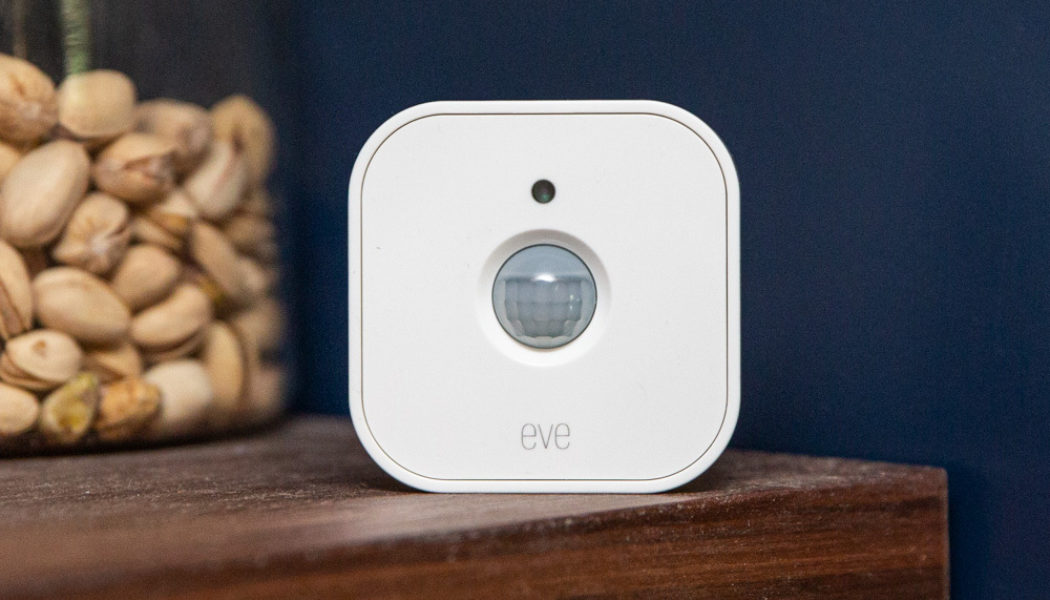A smart home without sensors and automations is basically a remote-controlled home. Using your voice or an app to turn lights on isn’t much easier (and in some cases is harder) than flicking on a light switch. Smart is when lights just turn on as you walk into a room. But when you walk in and they don’t turn on, that’s worse. This common smart home frustration is something the Eve Motion Sensor ($39.99), with its shiny new Thread protocol on board, promises to fix.
Thread is a mesh networking protocol designed for the smart home. It claims to be faster, more reliable, and more energy-efficient than the current smart home protocols most sensors run on — Bluetooth LE, Zigbee, and Z-Wave. (Don’t buy Wi-Fi motion sensors. They are not good.) While all of these protocols have mesh components, Thread’s selling point is that it doesn’t have a single point of failure in the form of a single hub or bridge devices need to connect to.
How we review and rate products
I have motion sensors everywhere in my house from a number of manufacturers, all working to turn my lights on and off. I also use one to kickstart my morning routine. A sensor in my bedroom tells my kettle to start boiling, turns on the lights, plays my favorite radio station from a smart speaker, and adjusts the thermostat. All I have to do is get out of bed.
But my biggest complaints are that sometimes these sensors aren’t as fast as flipping a switch, and sometimes they don’t work at all. This is often down to how they communicate. In my two weeks with the Eve Motion, I never had this problem. It worked quickly and responded reliably — as long as it was on my home’s Thread network. When it was forced over to Bluetooth (which is what the previous Eve Motion ran on), it was slower and less reliable.
:no_upscale()/cdn.vox-cdn.com/uploads/chorus_asset/file/23921608/jtuohy_220801_226099_0002.jpg)
The new Eve Motion is the second-generation motion sensor from the European smart home company. The biggest changes, beyond the addition of Thread, are size (it’s much smaller), price (it’s a bit cheaper), and a new additional sensor (it can now measure light levels as well). It also uses two AAA batteries instead of two AAs, but battery life is still one year, according to Eve. It keeps the water resistant IPX3 rating of the earlier model, so this is still a good option for use in a bathroom or covered porch.
Currently, Eve’s products only work on Apple’s HomeKit platform, so you need an iPhone or iPad to set this up. You also need an Apple Home hub (such as a HomePod or Apple TV) to create automations and scenes with the Eve Motion. To take advantage of the new Thread protocol, you will need a HomePod Mini or Apple TV 4K (second gen or newer). Without one of those, the sensor will work over Bluetooth LE.
:no_upscale()/cdn.vox-cdn.com/uploads/chorus_asset/file/23921606/jtuohy_220801_226099_0001.jpg)
In testing the Eve Motion to trigger lights to turn on and off based on motion and light levels in various rooms of my house — my laundry room, kitchen, dining room, and an upstairs hallway — response time was impressive. It turned them on instantly when I walked in, even in the farthest corners of my house, where Eve’s earlier Bluetooth motion sensor had struggled to keep up.
But while its reactions were excellent, the Eve Motion isn’t noticeably faster than the Hue and Aqara motion sensors I use. The big difference is it always worked. Both of those Zigbee-based sensors require a dedicated hub — that single point of failure I was talking about. The Eve Motion uses Thread, which — in a robust Thread mesh network — means it has backup options.
A Thread network can have multiple routers (smart plugs, smart bulbs) and border routers (Apple HomePod Mini, second-generation Apple TV 4K) working together to relay messages to devices. If one goes down, the motion sensor can just talk to another one. If my Hue bridge or Aqara hub get disconnected or go down, all my automations stop working.
I tested Thread’s robustness by disabling the Eve smart plug and HomePod Mini that the Eve Motion was relying on and retesting. (I can see the Thread network topology in Eve’s app.) It always continued to work, and while the network did take a few moments to reconfigure when a device went offline, I didn’t have to do any troubleshooting other than waiting a few seconds.
The only time I had any other issues with the Eve Motion was when I disabled all my Thread devices. Then the sensor kicked over to Bluetooth, and the reaction speed dropped dramatically — taking over five seconds in some places to respond to motion.
Eve has said all its Thread devices will support Matter when the smart home standard is released later this year. And when it arrives, there will be many more Thread border routers and devices the Eve Motion can rely on — including smart speakers from Google and Amazon. You’ll also be able to use Eve’s motion sensor and its other Thread products with those smart home platforms when Matter launches. But for now, it’s Apple HomeKit only.
:no_upscale()/cdn.vox-cdn.com/uploads/chorus_asset/file/23923936/Eve_Apple_automation.jpg)
Setting up the Eve Motion was simple, open the Apple Home app or Eve app and scan the HomeKit code. You can then set up automations using the sensor. The Home app will suggest some for you based on which room you’ve placed it in. You can also create your own using “motion detected” or “no motion detected” as triggers.
The new LUX sensor in the Eve Motion also lets you create automations based on how bright it is in a room. For example, you can set it not to trigger lights on motion if the room is bright enough already. It can also pair with smart shades, such as Eve’s MotionBlinds, to adjust the shades based on the light level in the room.
:no_upscale()/cdn.vox-cdn.com/uploads/chorus_asset/file/23921611/jtuohy_220801_226099_0006.jpg)
Here is where I would have liked to see a temperature sensor included — which is in the Philips Hue sensor, this model’s closest competition. I live in the South, where it gets very hot, and I like to create automations that close the shades in a room if both the light level is high and the temperature rises above 78 degrees Fahrenheit. You could do this with Eve by adding an Eve Room or Eve Weather sensor, both of which detect temperature, but those cost $99 and $80, respectively, whereas the Hue Motion Sensor is $45.
Bear in mind that the more advanced automations work best when set up in the Eve app, as the Home app is limited when it comes to setting multiple conditions (unless you use the complicated Shortcuts workaround). The Eve app adds more options, such as only triggering motion in darkness, adjusting the motion sensitivity (low / medium / high), and changing the motion re-trigger time. This last one is helpful to tweak if you find your lighting automations keep turning off sooner than you want.
:no_upscale()/cdn.vox-cdn.com/uploads/chorus_asset/file/23924103/Eve_App__3_.jpg)
Overall, I was impressed with the Eve Motion and can see how this type of reliability and speed can make the smart home a better experience. But while there are more Thread border routers and compatible devices today than there were just a year ago, there still aren’t enough to make this an unequivocal recommendation. And Thread border routers from different manufacturers still can’t talk to each other (although a fix is coming).
If you don’t have any type of Thread network set up in your home, don’t buy this. Without Thread, the Eve Motion reverts to Bluetooth LE, which is nowhere near as fast or reliable as Zigbee or Thread. If all you want is to turn lights on and off, you’ll be better off with the excellent Philips Hue Motion Sensor ($45 plus a Hue bridge). The Hue app has much simpler automation options for lighting control, and it works with Apple’s HomeKit, Amazon Alexa, Google Home, and Samsung SmartThings.
However, if you are like me and are gearing your smart home up to work with Matter when the standard arrives later this year, this little gadget will be an excellent block on which to build a truly smart home.
Photos by Jennifer Pattison Tuohy / The Verge









